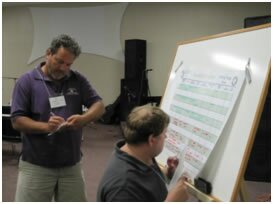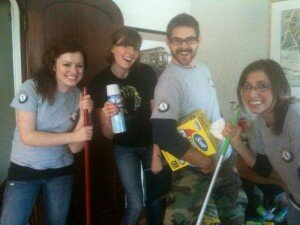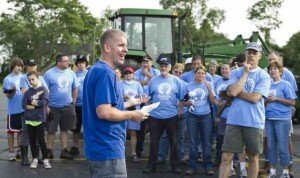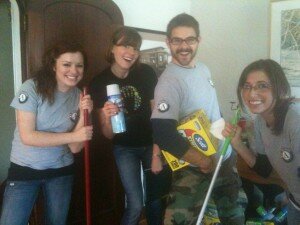AmeriCorps member are among some of the many unsung heroes of Joplin’s May 22 killer tornado.
They were among the first to arrive and will be among the last to return home.
Although not the most well-known federal program, AmeriCorps place over 75,000 Americans in volunteer roles that help citizens and non-profit agencies increase their productivity and effectiveness.
 Bruce Bailey, Director of Americorps-St. Louis, was in Kansas City on business at the time the tornado struck on Sunday evening. He arrived in Joplin by 9 p.m. Members of AmeriCorps-St. Louis were told as early as 7:30 that evening they needed to mobilize. The first team was on the ground in Joplin by 2 a.m.
Bruce Bailey, Director of Americorps-St. Louis, was in Kansas City on business at the time the tornado struck on Sunday evening. He arrived in Joplin by 9 p.m. Members of AmeriCorps-St. Louis were told as early as 7:30 that evening they needed to mobilize. The first team was on the ground in Joplin by 2 a.m.
A total of about 125 AmeriCorps volunteers from a variety of locations are in Joplin.
Bailey says, in terms of disaster caused by tornados, Joplin’s was the worst.
“I have worked in 34 states for at least 20 years, as well as overseas,” Bailey says. “The only thing I can compare the Joplin tornado with was the one in Greensburg, Kan. but that was a much smaller community.”
“I have never witnessed the consequences of something so intense or so powerful as what we’ve seen in Joplin,” he says. “That’s the negative.”
“On the positive side, I have never seen such amazing community cohesion, with people pulling together.”
In the first days after the tornado, hundreds of volunteers arrived in Joplin. Some had medical or nursing training. Some were experts with heavy equipment. But many others had no actual experience outside of their own willingness to work. The job of the AmeriCorps Emergency Response Team (ERT) is to effectively manage these volunteers. It is, at the very least, a big job.
Non-medically trained volunteers were given a number of duties including transferring supplies, finding warehousing opportunities, setting up distribution points and sorting clothes and other supplies.
A large number of those have now gone home.
 Abby Simons an AmeriCorps-St. Louis member who serves as liaison with Missouri Southern State University, says the need for volunteers still exists.
Abby Simons an AmeriCorps-St. Louis member who serves as liaison with Missouri Southern State University, says the need for volunteers still exists.
“Right now, we need people,” the dark-haired young woman in her 20s says. “It’s not a day or two after the storm and many of the people who flooded in have gone home,” she states. “But we don’t want to forget about the need that Joplin still has.”
Simons, originally from Manchester, Mo., and a graduate of Truman State University with a degree in psychology, says volunteer coordination is a must.
“People want to give their time but they may not understand the process of volunteer management,” she says. “Many have never been in a disaster situation. It’s very important that volunteers should not mobilize without being self-sufficient in terms of housing, food and knowing what they are going to do.”
She says those wanting to help should contact the Volunteer Center. It is currently staffed by volunteers. The number to call in Joplin is .
“Make sure you are registered,” Simons says. “This is very important.”
In the first days after the Joplin disaster, people wanting to help lined up outside the Billingsly Student Center at MSSU where the Disaster Response Center was located. Every one of them was registered with AmeriCorps.
“Once we have projects in place, we would like to invite these people back,” Simons says.
Simons will complete her second year of service with AmeriCorps this summer. She had worked in disaster situations even before joining the program. She had taken part in church mission trips and, in college, helped New Orleans area residents after Hurricane Katrina.
“I went down to New Orleans and Mississippi three times,” she says.
The 25 St. Louis AmeriCorps members, plus 44 NCCC volunteers from Denver and 12 from the Washington State, have been sleeping in aerobic rooms and the Phelps Theatre at Missouri Southern. Next week, are in the process of moving to another location on campus during the day and Joplin’s Memorial Hall at night.
Simons says she can’t give enough praise to the MSSU faculty and staff, especially the IT Department which has helped establish computer links to the quickly-established Volunteer Center.
“They have gone above and beyond everything we asked,” she says. “They have supported us in everything we have done. We couldn’t have functioned without them.”
Simons says she knows the AmeriCorps team has been a vital step in the reaction to the Joplin tornado
“I think we have filled a huge role that could not have been managed so effectively if we were not here. This is what we are trained for,” she says.
Bailey says the work of AmeriCorps is by no means finished in Joplin.
“We’ll be providing service to people recovering from the tornado for some time,” he says. “This is especially good for the uninsured and under insured.”As we enter recovery, we’ll be helping out not only with temporary repairs but helping people rebuild their whole households.”

 No matter how well you plan a volunteer event or manage your volunteers, eventually something is going to happen that doesn’t quite go as planned. It’s important to address the problem quickly and professionally and getting back to normal.
No matter how well you plan a volunteer event or manage your volunteers, eventually something is going to happen that doesn’t quite go as planned. It’s important to address the problem quickly and professionally and getting back to normal. Try to understand what has happened that has created some difficulty. Take a moment to reflect on the problem to try to find the root of it. What’s going wrong at the moment needs to be addressed, but there may be a deeper cause of the problem.
Try to understand what has happened that has created some difficulty. Take a moment to reflect on the problem to try to find the root of it. What’s going wrong at the moment needs to be addressed, but there may be a deeper cause of the problem. Once the problem is solved, move on. Try not to dwell on the problem once it’s solved. Don’t keep rolling the situation around in your head, it will only make you anxious and stressed.
Once the problem is solved, move on. Try not to dwell on the problem once it’s solved. Don’t keep rolling the situation around in your head, it will only make you anxious and stressed.
 Volunteer work has become increasingly responsible, sophisticated, and complex. There are many excellent reasons to write policies around voluntary action in nonprofit organizations. Such policies can be used to establish continuity, to ensure fairness and equity, to clarify values and beliefs, to communicate expectations, to specify standards, and to state rules. Read on as we share six important principles of writing volunteer policies.
Volunteer work has become increasingly responsible, sophisticated, and complex. There are many excellent reasons to write policies around voluntary action in nonprofit organizations. Such policies can be used to establish continuity, to ensure fairness and equity, to clarify values and beliefs, to communicate expectations, to specify standards, and to state rules. Read on as we share six important principles of writing volunteer policies.
 nteers is an unrealistic goal.
nteers is an unrealistic goal. are able to serve again. Keep in touch with them to let them know that you care about their well-being.
are able to serve again. Keep in touch with them to let them know that you care about their well-being.
 mean more because they are not paid to give it.
mean more because they are not paid to give it.
 It is important to provide inclusive projects for both your volunteers and your staff members to guarantee retention. When volunteers feel their work is both meaningful and fulfilling, they are more likely to return.
It is important to provide inclusive projects for both your volunteers and your staff members to guarantee retention. When volunteers feel their work is both meaningful and fulfilling, they are more likely to return. Specialist for HandsOn University.
Specialist for HandsOn University.

 Abby Simons an AmeriCorps-St. Louis member who serves as liaison with Missouri Southern State University, says the need for volunteers still exists.
Abby Simons an AmeriCorps-St. Louis member who serves as liaison with Missouri Southern State University, says the need for volunteers still exists.
 Today’s post comes from Anna Hoyt, an AmeriCorps VISTA serving with the C4 Network.
Today’s post comes from Anna Hoyt, an AmeriCorps VISTA serving with the C4 Network. I resolved to find a way to utilize my resources to make the day of service successful. Through the network that HandsOn and AmeriCorps provide, I was able to call up another AmeriCorps member serving in another part of the Seattle area who was coordinating a completely different project. She invited me to join in her effort to clean transitional homes for AIDS victims moving from the crisis of homelessness to self-sufficiency through a local organization. I had an incredible day serving alongside fellow community members and sharing in a great day of service to honor Martin Luther King Jr. What could have been a very discouraging day resulted in a new opportunity to partner with others and make a real impact in our community.
I resolved to find a way to utilize my resources to make the day of service successful. Through the network that HandsOn and AmeriCorps provide, I was able to call up another AmeriCorps member serving in another part of the Seattle area who was coordinating a completely different project. She invited me to join in her effort to clean transitional homes for AIDS victims moving from the crisis of homelessness to self-sufficiency through a local organization. I had an incredible day serving alongside fellow community members and sharing in a great day of service to honor Martin Luther King Jr. What could have been a very discouraging day resulted in a new opportunity to partner with others and make a real impact in our community.

